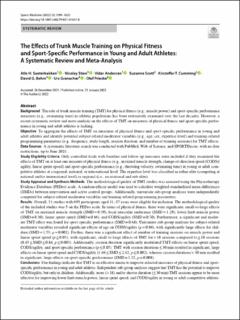| dc.identifier.citation | Saeterbakken, A. H., Stien, N., Andersen, V., Scott, S., Cumming, K. T., Behm, D. G., Granacher, U., & Prieske, O. (2022). The Effects of Trunk Muscle Training on Physical Fitness and Sport-Specific Performance in Young and Adult Athletes: A Systematic Review and Meta-Analysis. Sports Medicine, 52, 1599-1622. | en_US |
| dc.description.abstract | Background
The role of trunk muscle training (TMT) for physical fitness (e.g., muscle power) and sport-specific performance measures (e.g., swimming time) in athletic populations has been extensively examined over the last decades. However, a recent systematic review and meta-analysis on the effects of TMT on measures of physical fitness and sport-specific performance in young and adult athletes is lacking.
Objective
To aggregate the effects of TMT on measures of physical fitness and sport-specific performance in young and adult athletes and identify potential subject-related moderator variables (e.g., age, sex, expertise level) and training-related programming parameters (e.g., frequency, study length, session duration, and number of training sessions) for TMT effects.
Data Sources
A systematic literature search was conducted with PubMed, Web of Science, and SPORTDiscus, with no date restrictions, up to June 2021.
Study Eligibility Criteria
Only controlled trials with baseline and follow-up measures were included if they examined the effects of TMT on at least one measure of physical fitness (e.g., maximal muscle strength, change-of-direction speed (CODS)/agility, linear sprint speed) and sport-specific performance (e.g., throwing velocity, swimming time) in young or adult competitive athletes at a regional, national, or international level. The expertise level was classified as either elite (competing at national and/or international level) or regional (i.e., recreational and sub-elite).
Study Appraisal and Synthesis Methods
The methodological quality of TMT studies was assessed using the Physiotherapy Evidence Database (PEDro) scale. A random-effects model was used to calculate weighted standardized mean differences (SMDs) between intervention and active control groups. Additionally, univariate sub-group analyses were independently computed for subject-related moderator variables and training-related programming parameters.
Results
Overall, 31 studies with 693 participants aged 11–37 years were eligible for inclusion. The methodological quality of the included studies was 5 on the PEDro scale. In terms of physical fitness, there were significant, small-to-large effects of TMT on maximal muscle strength (SMD = 0.39), local muscular endurance (SMD = 1.29), lower limb muscle power (SMD = 0.30), linear sprint speed (SMD = 0.66), and CODS/agility (SMD = 0.70). Furthermore, a significant and moderate TMT effect was found for sport-specific performance (SMD = 0.64). Univariate sub-group analyses for subject-related moderator variables revealed significant effects of age on CODS/agility (p = 0.04), with significantly large effects for children (SMD = 1.53, p = 0.002). Further, there was a significant effect of number of training sessions on muscle power and linear sprint speed (p ≤ 0.03), with significant, small-to-large effects of TMT for > 18 sessions compared to ≤ 18 sessions (0.45 ≤ SMD ≤ 0.84, p ≤ 0.003). Additionally, session duration significantly modulated TMT effects on linear sprint speed, CODS/agility, and sport-specific performance (p ≤ 0.05). TMT with session durations ≤ 30 min resulted in significant, large effects on linear sprint speed and CODS/agility (1.66 ≤ SMD ≤ 2.42, p ≤ 0.002), whereas session durations > 30 min resulted in significant, large effects on sport-specific performance (SMD = 1.22, p = 0.008).
Conclusions
Our findings indicate that TMT is an effective means to improve selected measures of physical fitness and sport-specific performance in young and adult athletes. Independent sub-group analyses suggest that TMT has the potential to improve CODS/agility, but only in children. Additionally, more (> 18) and/or shorter duration (≤ 30 min) TMT sessions appear to be more effective for improving lower limb muscle power, linear sprint speed, and CODS/agility in young or adult competitive athletes. | en_US |

